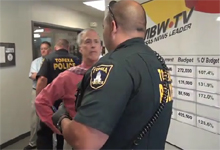Anybody who works in a TV or radio station, newspaper or online newsroom should look at the photos from the attack on employees at WIBW-TV in Topeka, Kan., and consider what you are doing to stay safe.
A knife-wielding man with gripes about the Veterans Administration wanted his story told. When News Director Jon Janes turned him away, the man came back and tossed a lamp through a security door. Ray Miles was free to roam the hallways of the station. Eventually, staffers wrestled him to the floor. (Watch surveillance video of him breaking in and later being subdued.)
“When they called me to come talk with this man, I was in a station-sponsored CPR class,” Janes told me. “Our security procedure is that the receptionist, who in this case was my wife, talks to the person by a security phone. If we are convinced the person has business at the station she buzzes the visitor into the atrium.”
The atrium leads to locked security doors into the station.
Janes said his station uses code words that, when spoken over the station’s PA system, means for everyone to evacuate or lock down their areas. “The system worked pretty well,” Janes said. But the station learned some lessons.
“We are going to remove furniture from the atrium,” Janes said. Miles used a heavy lamp to break the security door glass. “We also learned that we should have that security shatter-proof glass in the door,” Janes added.
“Newsrooms are public places and people who have grievances and issues see them as a public forum,” Radio Television Digital News Association Executive Director Mike Cavender told me. “It is clear that anybody who is in this line of work has some vulnerability, and companies would do well to bring in expert advice to be sure that they are doing what they can to keep people safe.”
Cavender says as he travels around the country, he seldom finds a station of any size that does not at least have a locked entrance and security doors. In larger cities, it is not unusual to encounter guards and multiple electronic doors that require key (or key card) access. “I started to see these before 9/11 but they became even more secure after then,” Cavender said.
While journalists are in far greater danger outside of the office than inside, the archives are rich with stories of viewers and readers who show up with weapons.
- In 2010, a woman with a gun stood in the lobby of WSOC-TV in Charlotte, North Carolina.
- In 2005, a Miami city councilman took his own life while standing in the lobby of the Miami Herald.
- Over the years, newsrooms have encountered packages with suspicious powder. In 1998, a suicidal gun-toting ex-convict showed up at the Concord Monitor saying he had a story to tell. Nine months earlier, a man gunned down Dennis Joos, the editor of the weekly News and Sentinel in Colebrook, New Hampshire in a newsroom attack.
Longtime news director Kevin Benz, currently Editor-in Chief of CultureMap, Austin and Chairman of RTDNA, says, “There was a time when news stations came into people’s living rooms in the evening. We seemed distant.” But things have changed.
“With social media, we have invited the public to have personal relationships with our folks. We cultivate a closeness, an expectation that ‘you are my friend and you can help me if I go over and talk to you.’ ” Benz says news organizations can build fortresses to stay safe, but it would seal them from the public they serve. These days, he says, journalists have to be accessible, “and there is an inherent risk in that.”
If you add up their years of experience, Cavender and Janes would represent over a half-century of working in newsrooms. And neither could remember a time when they had been part of a safety drill for what to do in the event of a security breach.
“Maybe we need to raise our consciousness to such things,” Cavender said.








Comments